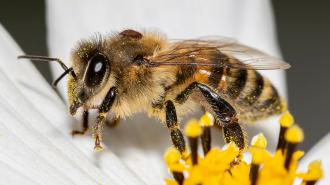The first large-scale trial of honey bees bred to resist the Varroa mite parasite found that they were more than twice as likely to survive the winter as other bees.
“This kind of resistance provides a natural and sustainable solution to the threat posed by Varroa mites, and does not rely on chemicals or human intervention,” said researcher Thomas O’Shea-Wheller, an evolutionary biologist at the University of Exeter.
90 crops grown in the US must be pollinated by insects, and bees are our primary pollinator.
Why it matters: Bee colonies do more than just produce honey. They also provide us with beeswax, bee venom, and several other products that we eat or use for medicines.
More importantly, 90 crops grown in the US — including apples, almonds, and blueberries — must be pollinated by insects, and bees are our primary pollinator. Throughout the year, farmers hire beekeepers to bring their colonies to their farms to pollinate crops.
The challenge: Maintaining a healthy bee colony is not easy, and commercial beekeepers in the US are losing around 40% of their bee populations every year. Pesticides, viruses, and other factors contribute to these losses, but the Varroa mite is bees’ biggest threat.
These tiny parasites feed off honey bees and larvae. This can disrupt the bees’ behavior, development, and immune systems, leading entire colonies to break down — a phenomenon called “colony collapse disorder.” The mites can also spread viruses between bees.
“So far, new methods to control the mites — and the diseases that they carry — have had limited success, and the mites are becoming increasingly resistant to chemical treatments,” said O’Shea-Wheller. “It’s a ticking time-bomb.”
Commercial beekeepers in the US are losing around 40% of their bee populations every year.
Pol-line bees: Some bees take the problem of the Varroa mite into their own tiny claws, pushing infected larvae out of the hive. This behavior is known as “Varroa-sensitive hygiene.”
Through selective breeding, the USDA‘s Agricultural Research Service created the “Pol-line bee,” a line that exhibits high levels of hygiene, as well as several other beneficial characteristics, including a propensity to produce a lot of honey.
No one had ever directly compared Pol-line bees to standard ones on a large scale before, though, so that was the goal of this new study, which was a collaboration between the USDA, Exeter, and Louisiana State University.
Some bees perform behaviors to get rid of Varroa mites. ”Pol-line bees” were bred to exhibit high levels of those behaviors.
A bzzzy year: The study started in Mississippi with 173 Pol-line bee colonies and 193 colonies of standard commercial bees.
The bees were then moved around the US for a year to mimic industry protocol and expose the bees to different environments. Some went to South Dakota and California to pollinate crops, some only pollinated crops in South Dakota, and others stayed in Mississippi.
Half of the colonies in each group were also treated with a chemical to control the Varroa mite twice throughout the year, while the other half received the treatment just once.
The results: Overall, the Pol-line bee colonies had fewer Varroa mites in their midst and were more than twice as likely to survive the winter compared to the standard bees: a 60% survival rate compared to 26%.
The Pol-line bees that received the Varroa mite treatment twice had a winter survival rate of 72% compared to 56% for the double-treated standard bees. In the single treatment groups, rates dropped to 56% for Pol-line bees but plummeted to just 9% for standard bees.
Pol-line colonies had fewer Varroa mites and were more than twice as likely to survive the winter.
Surprise discovery: The Pol-line bees also showed lower levels of three viruses commonly spread by the Varroa mite, but the researchers were surprised to see that the viruses themselves didn’t impact bee mortality as much as they expected.
“A lot of research is focussed on the viruses, with perhaps not enough focus on the mites themselves,” said O’Shea-Wheller.
“The viruses are clearly important, but we need to take a step back and be rigorous in delivering the best practical outcomes, because if you control the mites, you automatically control for the viruses that they transmit,” he continued.
We’d love to hear from you! If you have a comment about this article or if you have a tip for a future Freethink story, please email us at [email protected].






